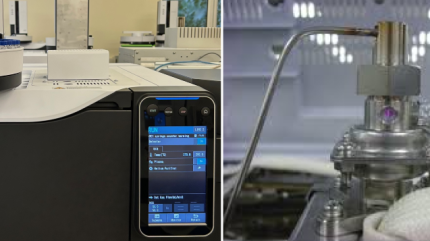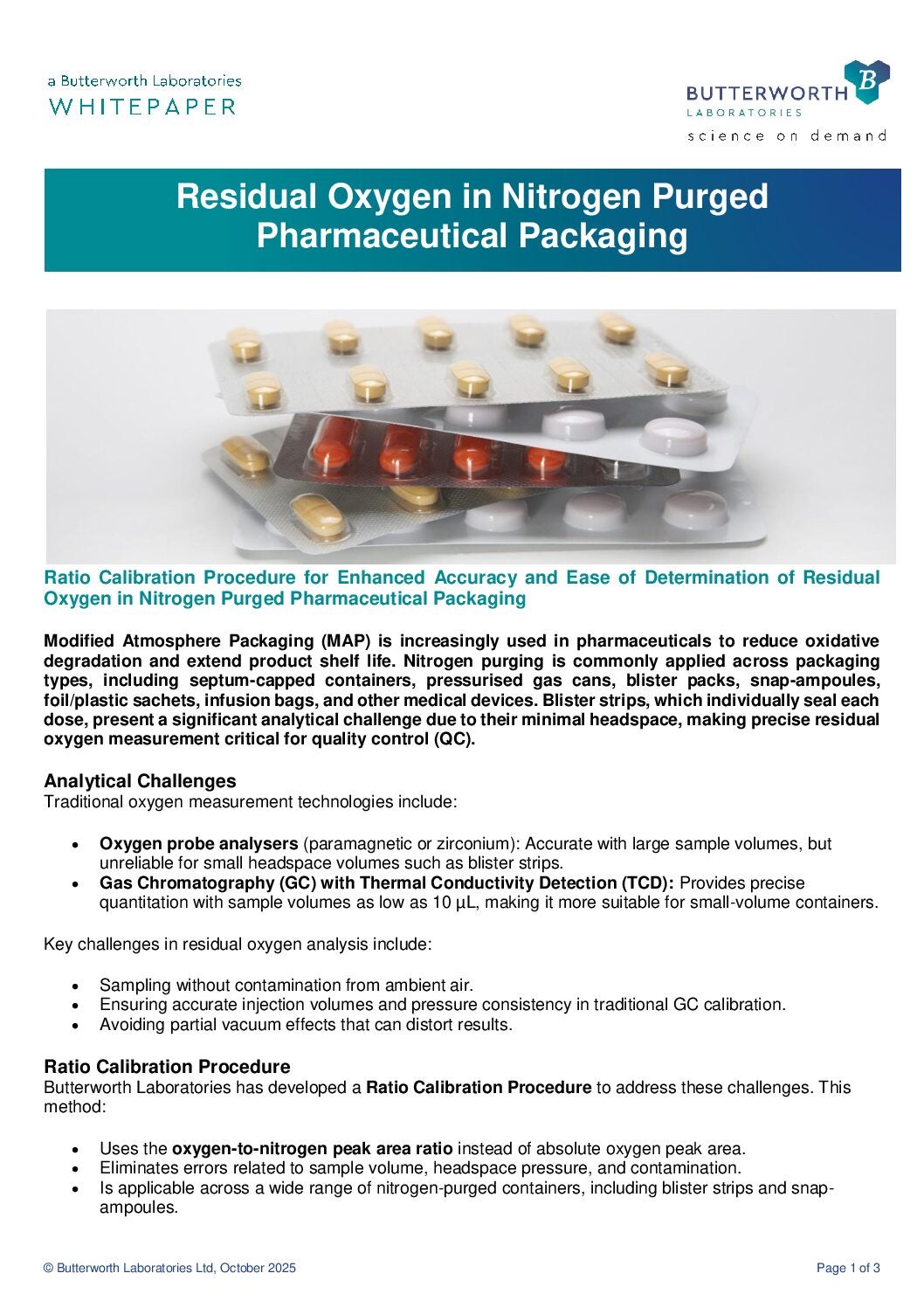
Gas chromatography (GC) remains an indispensable analytical tool in the pharmaceutical industry, supporting tasks ranging from residual solvent analysis and headspace testing to process gas monitoring and excipient quality control. Yet, with increasing demands for trace-level quantitation, multi-component analysis, and regulatory-compliant testing, traditional GC detectors such as the Thermal Conductivity Detector (TCD) or Flame Ionisation Detector (FID) often reach their performance limits1. The Barrier Ionisation Discharge (BID) detector, introduced by Shimadzu in the early 2010s2, is emerging as a powerful solution for these challenges. Leveraging dielectric barrier discharge plasma technology2, BID combines universal detection, high sensitivity, and broad linear dynamic range, making it particularly relevant for pharmaceutical GC detection applications2.
What is the BID Detector?
The BID detector generates a stable helium (He) plasma within a dielectric barrier discharge cell2. The plasma emits high-energy photons (~17.7 eV) capable of ionising nearly all compounds except helium and neon2. As analytes elute from the GC column, they are ionised by this plasma, and the resulting ions are collected at an electrode, producing a measurable signal2.
In essence, the BID operates as a universal, non-destructive detector, capable of detecting organic and inorganic compounds, permanent gases, and volatile solvents at trace levels2,3.
How BID Works
The ionisation process in BID relies on Penning ionisation2:
- Helium gas is energised in a dielectric barrier discharge, producing a plasma2.
- High-energy helium species interact with eluting analytes, creating ions2.
- The ions are attracted to a collection electrode, generating an electrical signal proportional to analyte concentration2.
Because the plasma is independent of combustion or radioactive sources2, the BID provides a safe, robust, and highly sensitive alternative to FID, ECD, and TCD for pharmaceutical labs2.
Why BID Matters for Pharmaceutical Testing
1. Universal Detection
BID can detect almost any compound, including2,3 :
Permanent gases: O₂, N₂, H₂, CO, CO₂
- Hydrocarbons: C1–C12 and above
- Inorganic gases: H₂S, SO₂, NOx
- Solvents and volatile organics
This universality allows simultaneous multi-component analysis2, eliminating the need for multiple detectors and reducing analytical complexity.
2. High Sensitivity
BID’s limit of detection (LOD) is approximately 0.05 ng, outperforming TCD (~10 ng) and matching or exceeding FID/ECD (~0.1 ng) 1. This high sensitivity is essential for:
- Trace residual solvent testing3
- Low-level headspace gas monitoring3
- Dissolved gas quantitation in excipients or process solvents2
3. Wide Linear Dynamic Range
The detector typically exhibits five orders of magnitude of linearity2, enabling quantitation across trace to bulk concentrations in a single method.
4. Safety and Operational Ease
Unlike FID or FPD, BID requires no flame or combustible gases2, reducing laboratory risk and simplifying operation. This feature is especially attractive for GMP laboratories and controlled environments3.
BID vs Other Detectors in Pharmaceutical GC
| Detector | Sensitivity (LOD) | Universality | Selectivity | Linear Range | Key Notes |
| TCD | ~10 ng | Universal | Low | 3 orders | Standard for gas purity, low sensitivity1 |
| FID | ~0.1 ng | Organic only | Medium | 7 orders | Requires hydrogen flame1 |
| ECD | ~0.1 ng | Electro-negative compounds | High | 5 orders | Selective but limited to halogenated compounds1 |
| GC-MS | fg–pg | Universal | High | 4–6 orders | Complex, high cost1 |
| BID | ~0.05 ng | Universal | Medium | 5 orders | No flame, safe, sensitive for trace gases2 |
Table 1: Comparative performance of common GC detectors.
Applications in Pharmaceutical QC and R&D
The BID detector is particularly suited to pharmaceutical laboratories, supporting ICH-compliant workflows2 in areas including:
Residual Gas and Headspace Analysis
- Quantitation of O₂, CO₂, N₂, H₂ in lyophilised products or sterile vials3
- Ensuring correct modified-atmosphere packaging (MAP) conditions3
- Measuring process gas purging efficiency2
Trace Impurities in Solvents and Excipients
- Detection of VOCs in excipients, raw materials, or formulations3
- Monitoring process-related impurities below regulatory thresholds2
Process Gas Monitoring
- Control of nitrogen or helium purging in GMP manufacturing3
- Monitoring hydrogen or CO₂ impurities in active pharmaceutical ingredient (API) production2
By combining trace-level sensitivity with universal detection2, BID allows pharmaceutical labs to reduce method complexity, increase throughput, and meet ICH Q2(R2) and Q3C/Q3D requirements2,3,6 for impurity profiling.
Method Development Considerations in GMP Environments
While BID offers multiple advantages2, successful implementation in pharmaceutical testing requires attention to:
- Carrier Gas: Helium is preferred; alternative gases reduce sensitivity2
- Sample Cleanliness: Prevent contamination to maintain signal stability2
- Baseline Stability: Use high-purity gas and stable flow to minimise noise2
- Maintenance: Periodic cleaning of the plasma cell and replacement of consumables ensures consistent performance2
- Injection Strategy: Splitless injection or headspace sampling enhances trace-level detection3
By adhering to these considerations, laboratories can achieve robust, reproducible, and validated BID methods2,3 suitable for regulated environments.
Regulatory Relevance: Meeting Global Pharmaceutical Standards
Pharmaceutical laboratories must ensure analytical methods meet global regulatory expectations2,3, including:
- ICH Q2(R2) – Validation of analytical procedures: accuracy, precision, specificity, LOD/LOQ, linearity, robustness2
- ICH Q3C/Q3D – Control of residual solvents and elemental impurities2
- USP and Ph. Eur. monographs – Headspace GC and gas analysis compliance3
BID enables laboratories to meet or exceed detection requirements2, particularly where traditional TCD or FID detectors may be insufficient for low-level gases or volatile impurities2,4. Its universal detection allows a single method to cover multiple analytes, simplifying compliance documentation and reducing validation complexity2,3,5.
Limitations and Practical Challenges
Despite its advantages2, BID has some practical limitations:
- Helium Consumption: High-purity helium is required both for the plasma and carrier gas2,3, which can impact cost and sustainability.
- Carrier Gas Restrictions: Alternative gases (hydrogen, nitrogen, argon) reduce detector performance2.
- Baseline Noise: Plasma instability or contamination can introduce signal drift2,3; although high-purity gas and regular maintenance can mitigate this to some extent.
- Sample Sensitivity: Less robust than FID when analyzing “dirty” or unfiltered samples2.
- Selectivity: BID is universal but does not distinguish compound classes, necessitating chromatographic resolution or complementary detectors2,3 when analyzing complex matrices.
The Butterworth Laboratories perspective
Butterworth Laboratories is beginning to pioneer BID method development for pharmaceutical GC detection2, helping clients meet stringent quality requirements while improving analytical efficiency3. By leveraging BID, pharmaceutical laboratories can:
- Replace TCD for trace gas analysis2
- Improve sensitivity in headspace and residual solvent testing3
- Simplify QC workflows through single-detector multi-analyte methods2
Butterworth’s team supports method development, validation, and regulatory documentation to ensure GMP-compliant implementation2,3.
For laboratories seeking to enhance pharmaceutical GC detection, BID represents a practical, high-performance solution2.
Transformation in gas chromatography
The BID detector represents a transformative step in pharmaceutical gas chromatography2,3, combining:
- High sensitivity (LOD ~0.05 ng) 2
- Universal detection for organic and inorganic compounds2
- Wide linear dynamic range (five orders of magnitude) 2
- Safe, flame-free operation2
- Regulatory compliance potential (ICH Q2(R2), Q3C/Q3D) 2,3
While considerations such as helium use, baseline stability, and maintenance2 must be addressed, BID provides a compelling alternative to traditional GC detectors for trace gas, solvent, and process monitoring in pharmaceutical environments.
Butterworth Laboratories continues to champion BID adoption, offering expertise in method development and regulatory alignment for pharmaceutical laboratories worldwide2,3.
For more information on integrating BID into your GC workflows, contact our specialists today.
References
- Shimadzu Scientific Instruments. Nexis GC-2030/2050 Barrier Ionisation Discharge Detector. Shimadzu Technical White Paper, 2021.
- McNair, H. M., & Miller, J. M. Basic Gas Chromatography, 2nd Edition. John Wiley & Sons, 2011.
- ICH. Q2(R2) Validation of Analytical Procedures: Text and Methodology, 2005.
- ICH. Q3C(R8) Impurities: Residual Solvents, 2016.
- European Pharmacopoeia. Monograph 2.2.29, Headspace Gas Chromatography, 11th Edition, 2023.
- Klee, M. et al. “Barrier Ionisation Discharge Detector: Applications in Pharmaceutical Gas Analysis.” Journal of Chromatographic Science, 2020; 58(7): 563–573.




